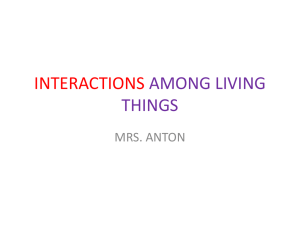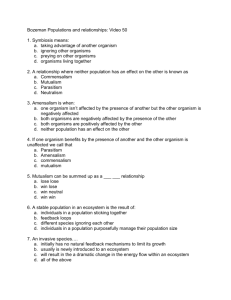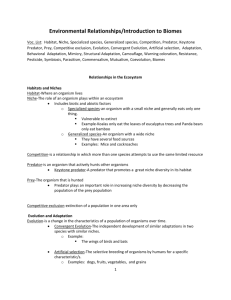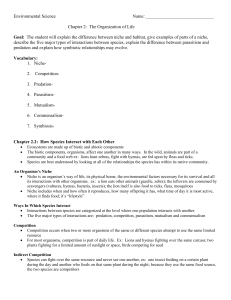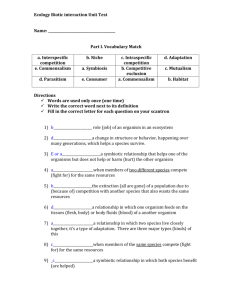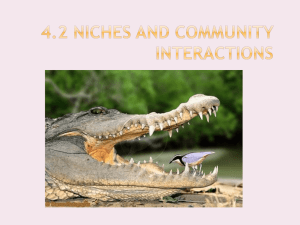Objective #3 Activities*Community Interactions
advertisement
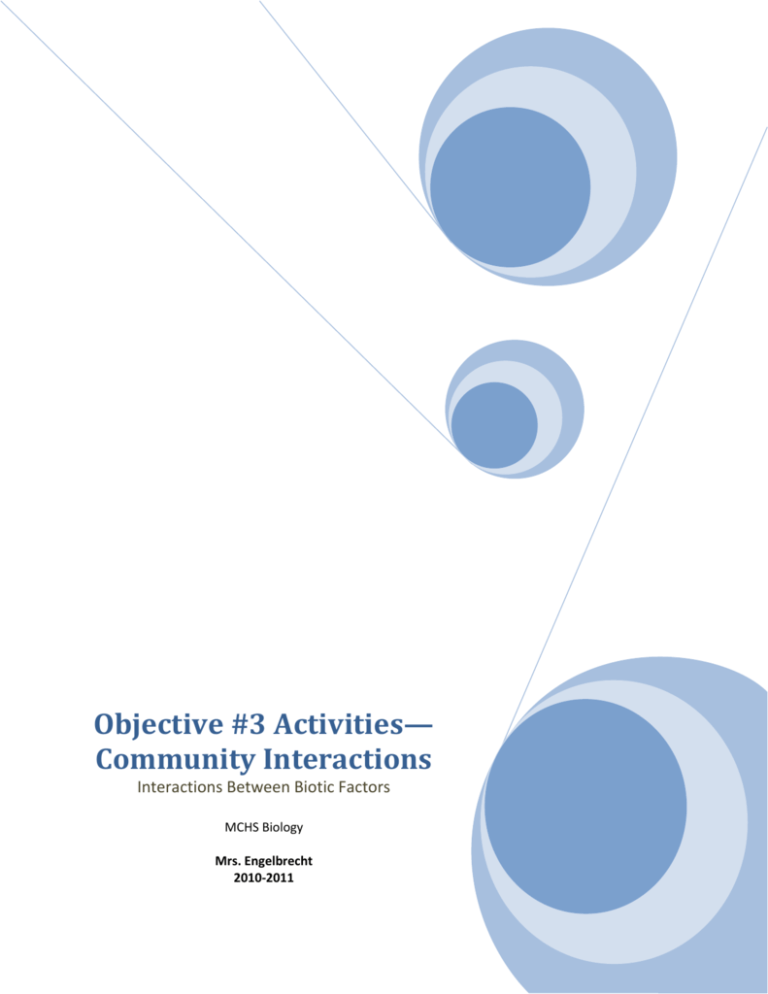
Objective #3 Activities— Community Interactions Interactions Between Biotic Factors MCHS Biology Mrs. Engelbrecht 2010-2011 Community Interactions—Objective #3 Objective #3: 3a. I can classify examples of as either a habitat or a niche. 3b. I can explain what happens when two organisms try to share the same niche. 3c. I can explain the difference between competition and predation. 3d. I can compare and contrast the three types of symbiotic relationships that occur in communities: mutualism, parasitism, and commensalism. Vocabulary Practice The words you will need to know for this objective are listed below: habitat niche predation mutualism commensalism competition parasitism A. Read each sentence below. Using the key below, write what you think about each sentence in the space next to each sentence number. T = true F = false M = maybe DK = don’t know _____ 1. The group of trees that a monkey lives in is its habitat. _____ 2. Fungi need a moist, humid climate in which to grow. This need for moisture is part of their niche. _____ 3. When two populations try to share the same niche or use the same resource, competition occurs and one of the populations will go extinct. _____ 4. If two organisms are competing, that means predation is occurring. _____ 5. If you get a tapeworm and it ends up living in your intestines, feeding off of every meal you eat, that means you and your tapeworm have a parasitic relationship. _____ 6. An example of commensalism would be you and the bacteria living in your intestines, because you give them a home, and they break down food and synthesize vitamins for you. _____ 7. Mutualism is where both organisms in the relationship benefit from the relationship. B. Read p. 38-40 of your textbook, looking for whether the statements above are TRUE or FALSE. Change your answers to the above sentences. This time, you may NOT use “M” or “DK.” PUT YOUR BOOKS BACK WHEN YOU’RE DONE. 2 C. Fill in the chart below that summarizes your knowledge of the vocabulary words: Word Your own definition Rename the word in 3 words or less Specific example habitat niche competition predation mutualism parasitism commensalism 3 Reading For Understanding—Practice Read the passage below concerning how biotic factors interact in communities. Remember, while you’re reading, do the following: A. As you are reading, underline any definitions of vocabulary words you find. Change your definitions in the chart if you need to. B. Mark the following as you read: DGT = I don’t get this. I had to re-read this to try and understand it. !! = I am surprised to find this out ?? = I have a question about this (write your question in the margin) Your Intestinal Bacteria and You—A Study in Community Interactions Whether you know it or not, you are a member of a community. Yes, you are a member of the Marengo community, but you also belong to your ecological community. Think about what a community is for a second—it is a group of populations (which are going to be made of different species) that all live in the same area. Obviously you are a part of the human population in Marengo, but what about the other populations of organisms in Marengo? All the dogs in the area constitute a population, as well as all of the cats people keep as pets. Then there are all of the amphibians, insects, and other creatures Mrs. E is afraid to touch that all have their own populations in Marengo. And let’s not leave out the populations we can’t see—the bacteria living on every person and surface in the town, as well as the protists and fungi living here as well. So, in our Marengo community, there are many different populations of organisms, all living in this quiet little spot we call Marengo. Generally speaking, all of the different populations of different species live in Marengo, but each population has a specific location where it lives, called its habitat. For example, your habitat is the house in which you live; the habitat of the E. coli inside of you is your large intestine. A habitat can be large, or it can be very small. For example, a species of moss might spend its entire life living on one tree, so that one tree is considered its habitat. However, a mantled howler monkey is going to live in several trees, since it will move from tree to tree. While a habitat is simply where an organism lives, its niche is a very different concept altogether. An organism’s niche tells you how it lives; in other words, what are the requirements that organism has to have in order to survive and compete successfully in its habitat. For example, the habitat of your E. coli is your large intestine; parts of its niche would be the temperature at which it grows best, how it obtains resources to survive, how much space it needs to grow, etc. Thus, a niche is much more than just a habitat—it is how an organism meets its needs to survive and reproduce where it lives. 4 Stop & Think a) A habitat is like _______________________________ because ______________________________________. b) A niche is like ________________________________ because ______________________________________. In the blank beside each example below, write an “H” if it is a habitat, and an “N” if it represents a niche. _____ Chicago suburbs _____ low light intensity _____ wetland _____ river _____ tropical climate _____ relative humidity While E. coli may be successful in its niche, living happily in its habitat of your large intestine, it is not alone—organisms in communities often interact, usually by trying to live in the same niche. This means that different organisms often try to meet their needs using the same resources in the same area. Examples of such resources include space, amount of light, food, water, shelter, etc. Sadly, though, the amount of resources in any habitat is limited—there isn’t enough to go around for all of the organisms trying to occupy the same niche. So, what will happen if two organisms try to use the same resources in the same niche? You can sum it up in one word—competition. When two organisms try to use the same resource in the same niche at the same time, competition will always occur. This competition can be fierce, if the resource over which they are competing is scarce, or it can be less intense if there is more of the available resource. For example, during times of drought, competition for water will be intense, while after a rainy period, the competition for water will be much less “do or die.” Speaking of death, competition isn’t always a fight to the death between two organisms. If a herd of horses and a herd of cattle are grazing in the same field, they are competing for the same resource—grass! However, you will not see the horses fighting the cows over the grass (If you do, please let me know. We have some more serious things to discuss than competition). Sometimes organisms simply emigrate to a new area in search of resources rather than directly compete with another organism. Stop & Think Two species of iguanas both like to live in the same part of the understory of a tropical forest (the understory is the region of the forest that grows beneath the taller trees, or canopy) because they can regulate their body temperatures better in the understory than in the canopy. a) Predict what could happen to the two iguana populations as they try to occupy the same niche. b)Predict how the two different iguana species could live in the same niche (the understory) WITHOUT competing. 5 When two organisms are competing for the same resource, another type of community interaction that can occur is called predation. Predation occurs when one organism consumes, or eats, another organism. The organism doing the eating is called the predator, and the organism being eaten is called the prey. What you must understand about predation is that it is NOT competition—it is something that happens because two organisms are competing for the same resource. In other words, predation occurs because two organisms are trying to use the same resource, all because, ultimately, they are occupying the same niche. Stop & Think Write the difference: Competition Predation Summarize your difference in one sentence: Study the two graphs below of a moose population and a wolf population that live in the same community. The dependent variable is the number of each organism; the independent variable is the year in which the population measurement was taken. (i.e., ’60 = 1960, ’70 = 1970, etc.) What about the two graphs above indicate that the moose and wolves are interacting in a predator-prey relationship? 6 Interactions between organisms in a community don’t always involve the act of eating. Sometimes, organisms have developed a relationship with another organism that enables one or more of them to survive in their niche. These types of relationships, where two organisms live in close contact with each other, are called symbiotic relationships. There are three types of symbiotic relationships seen in communities—mutualism, parasitism, and commensalism. When two organisms are in a mutualistic relationship, both organisms benefit from living together. In other words, it is a “win/win” situation for both organisms. The type of symbiotic relationship in which one organism is harmed while the other organism benefits is called a parasitism. Parasitism can be considered a “win/lose” situation. Finally, when two organisms live in close contact and one organism benefits, but the other organism is neither helped or harmed, that is called commensalism. Commensalism can be referred to as a “win/neutral” situation. Stop & Think You are a member of an ecological community, so you could possibly be interacting with your fellow community members through symbiotic relationships. For each type of symbiotic relationship, give an example of how YOU could be involved with another organism in that relationship. a) Mutualism: b) Parasitism c) Commensalism YOU and ___________________ YOU and ________________________ YOU and _____________________ Finish the analogies below: Mutualism is like ____________________ because __________________________________________________. Commensalism is like _____________________ because _____________________________________________. Parasitism is like ______________________ because _________________________________________________. d) Summarize why the three types of symbiotic relationships above are examples of COMMUNITY interactions. e) Write the differences: mutualism parasitism parasitism commensalism commensalism mutualism 7 As you can see, you are more than just a member of the Marengo community—you are a member of a larger ecological community, competing with other organisms (visible and invisible) that are occupying the same niche as yourself. Next time you are strolling around Marengo, think about all the ways you are interacting with ALL of the members of your community (even the parasites!), not just the human members. Making Connections—Practice Choose ONE of the options below that will help you make connections between the concepts discussed in the reading: A. Using your Planet X organisms, draw what a community would look like involving your organisms on poster paper. Then, draw an example of each one of the vocabulary words in your community. Your drawing must be sure to answer all of the I can statements. Have someone else look at your poster when you’re finished and rate your knowledge of the I can statements. B. Write me a wonderful, whimsical RAFT: (ALL vocab words must be used in such a way so that it is clear you understand the meaning of the word, and you must answer all of the I can statements!) When you’re finished, let someone else read it and score you on your knowledge of the I can statements. ROLE: Camp counselor telling stories around a campfire AUDIENCE: Young campers begging you to tell a scary story FORMAT: Story titled, “It Came From Your Niche” [insert scary horror movie music here] TOPIC: Scare the pants off your campers with all of the ways organisms in a community interact. FINISHED EARLY? Get your netbook and go to www.classzone.com. Select “High School” Next to “Science,” Click on Illinois, and then click “go.” Click on “Biology 2010.” From the drop-down menu that says “chapter home,” select Chapter 14. Click on “Animated Biology,” then click “Chapter 14: Survive within a Niche.” Follow the on-screen directions to complete the activity. 8 Rate Your Understanding of the I Can Statements When you’re finished, rate yourself on the I cans using the chart below: Community Interactions 0 1 2 3 4 3A. I can classify given examples as either a habitat or a niche. 3B. I can explain what happens when two organisms try to share the same niche. 3C. I can explain the difference between competition and predation. 3D. I can compare and contrast the three types of symbiotic relationships that occur in communities: mutualism, parasitism, and commensalism. Determine Your Understanding of the I Can Statements 1)Take the Exit Ticket provided by your instructor. 2) Check your answers when you are finished. 3) Mark whatever you did not get correct on your exit ticket. 4) Re-rate yourself on how well you have mastered the I can statements in the rubric above. 5) Staple this page to the back of your Exit Ticket and turn it in to your period’s box. 9

